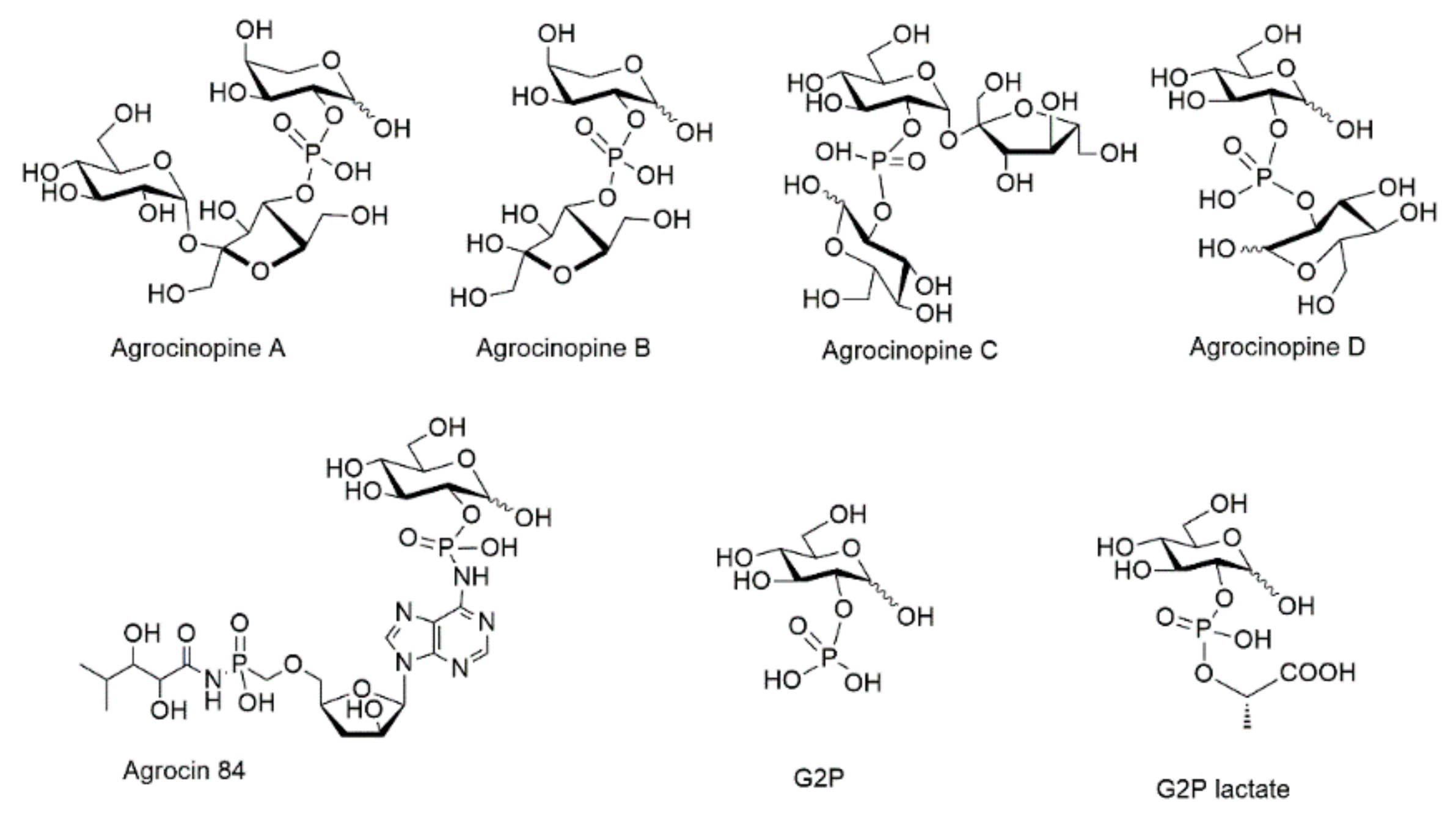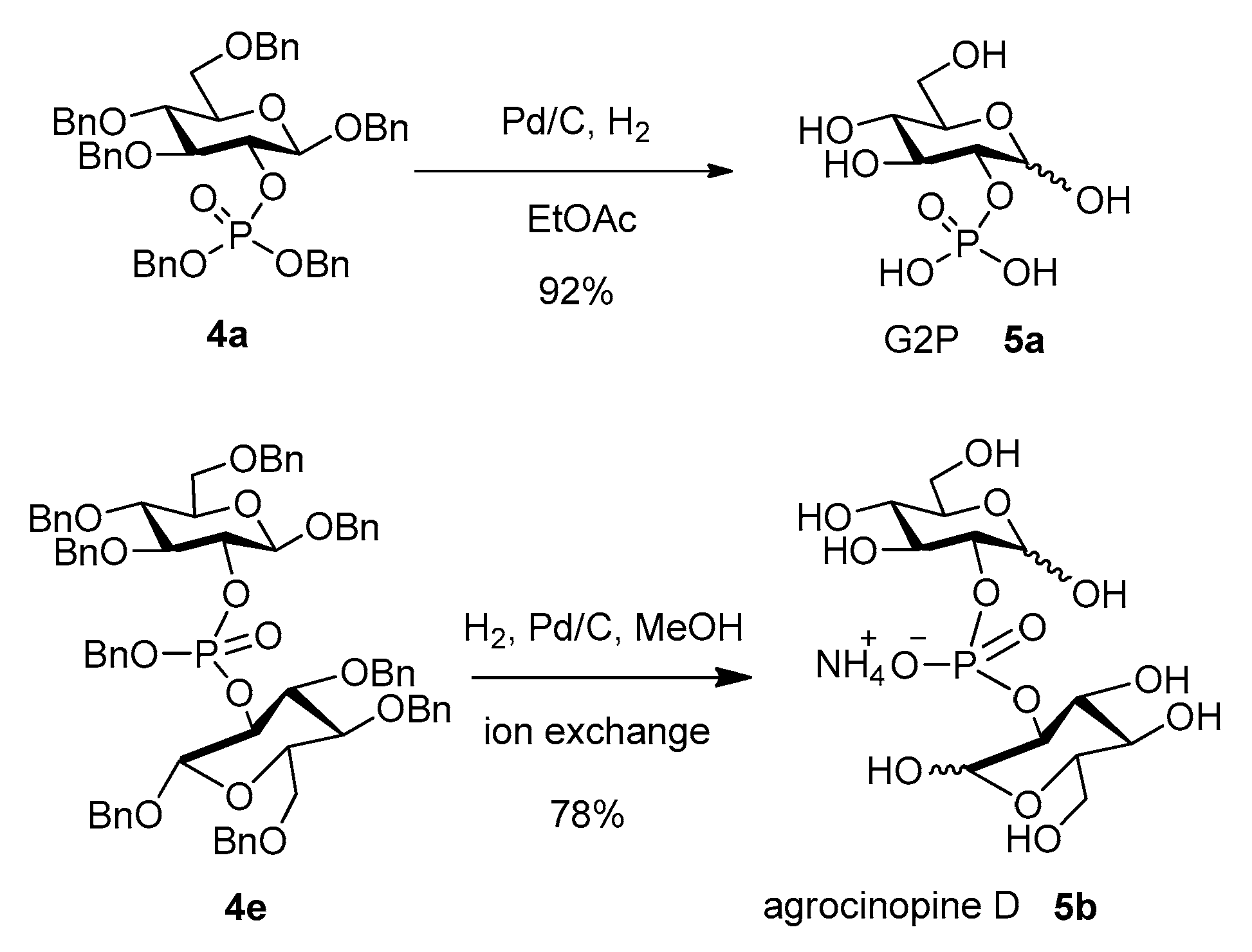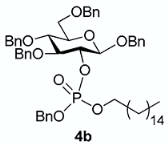Esters of Glucose-2-Phosphate: Occurrence and Chemistry
Abstract
1. Introduction
2. Results
2.1. Phosphorylation and Coupling Methods
2.2. Building Blocks
2.3. Alternative Flexible Access to G2P and Esters
3. Materials and Methods
3.1. General Methods
3.2. Synthesis of benzyl 3,4,6-tri-O-benzyl-2-O-[benzyloxy(diisopropylamino)phosphanyl]-β-D-glucopyranoside (or benzyl ((2R,3R,4S,5R,6R)-2,4,5-tris(benzyloxy)-6-((benzyloxy)methyl)tetrahydro-2H-pyran-3-yl) diisopropylphosphoramidite) 3
3.3. General Procedure for the two-step Synthesis of Phosphotriesters 4a–e
3.3.1. Benzyl 3,4,6-tri-O-benzyl-2-O-dibenzylphosphonato-β-D-glucopyranoside [or dibenzyl ((2R,3R,4S,5R,6R)-2,4,5-tris(benzyloxy)-6-((benzyloxy)methyl)tetrahydro-2H-pyran-3-yl) phosphate] 4a
3.3.2. Benzyl 3,4,6-tri-O-benzyl-2-O-[(benzyl)(hexadecyl)phosphonato]-β-D-glucopyranoside [or benzyl hexadecyl ((2R,3R,4S,5R,6R)-2,4,5-tris(benzyloxy)-6-((benzyloxy)methyl)tetrahydro-2H-pyran-3-yl) phosphate] 4b
3.3.3. Benzyl 3,4,6-tri-O-benzyl-2-O-[(benzyl)(cholesteryl)phosphonato]-β-D-glucopyranoside [or benzyl cholesteryl ((2R,3R,4S,5R,6R)-2,4,5-tris(benzyloxy)-6-((benzyloxy)methyl)tetrahydro-2H-pyran-3-yl) phosphate] 4c
3.3.4. Benzyl 3,4,6-tri-O-benzyl-2-O-[(benzyl)(5α-cholestan-3β-yl)phosphonato]-β-D-glucopyranoside [or benzyl cholestanyl ((2R,3R,4S,5R,6R)-2,4,5-tris(benzyloxy)-6-((benzyloxy)methyl)tetrahydro-2H-pyran-3-yl) phosphate 4d
3.3.5. Benzyl 3,4,6-tri-O-benzyl-2-O-[(benzyl)[(1,3,4,6-tetrabenzyl-β-d-glucopyranos-2-yl)phosphonato]-β-d-glucopyranoside [or benzyl bis((2R,3R,4S,5R,6R)-2,4,5-tris(benzyloxy)-6-((benzyloxy)methyl)tetrahydro-2H-pyran-3-yl) phosphate] 4e
3.4. Procedure for the one-step Synthesis of 4e
3.5. Procedure for the Debenzylation of Phosphodiesters 4a and 4e
3.5.1. d-Glucose-2-phosphate (G2P) 5a
3.5.2. Agrocinopine D 5b
4. Conclusions
Supplementary Materials
Author Contributions
Funding
Acknowledgments
Conflicts of Interest
References
- Beck Von Bodman, S.; Hayman, G.T.; Farrand, S.K. Opine catabolism and conjugal transfer of the nopaline Ti plasmid pTiC58 are coordinately regulated by a single repressor. Proc. Natl. Acad. Sci. USA 1992, 89, 643–647. [Google Scholar] [CrossRef] [PubMed]
- Ellis, J.G.; Kerr, A.; Petit, A.; Tempe, J. Conjugal transfer of nopaline and agropine Ti-plasmids-the role of agrocinopines. Mol. Gen. Genet. 1982, 186, 269–274. [Google Scholar] [CrossRef]
- Reader, J.S.; Ordoukhanian, P.T.; Kim, J.-G.; de Crécy-Lagard, V.; Hwang, I.; Farrand, S.; Schimmel, P. Major biocontrol of plant tumors targets tRNA synthetase. Science 2005, 309, 1533. [Google Scholar] [CrossRef] [PubMed]
- Roberts, W.P.; Tate, M.E.; Kerr, A. Agrocin 84 is a 6-N-phosphoramidate of an adenine nucleotide analogue. Nature 1977, 265, 379–381. [Google Scholar] [CrossRef]
- Thompson, R.J.; Hamilton, R.H.; Pootjes, C.F. Purification and characterization of agrocin 84. Antimicrob. Agents Chemother. 1979, 16, 293–296. [Google Scholar] [CrossRef]
- El Sahili, A.; Li, S.-Z.; Lang, J.; Virus, C.; Planamente, S.; Ahmar, M.; Guimaraes, B.G.; Aumont-Nicaise, M.; Vigouroux, A.; Soulère, L.; et al. A pyranose-2-phosphate motif is responsible for both antibiotic import and quorum-sensing regulation in Agrobacterium tumefaciens. PLoS Pathog. 2015, 11, e1005071. [Google Scholar] [CrossRef]
- Li, S.-Z.; Vigouroux, A.; Ahmar, M.; El Sahili, A.; Soulère, L.; Sago, L.; Cornu, D.; Moréra, S.; Queneau, Y. Synthesis of a non-natural glucose-2-phosphate ester able to dupe the acc system of Agrobacterium fabrum. Org. Biomol. Chem. 2019, 17, 1090–1096. [Google Scholar] [CrossRef]
- Mikkola, S. Hydrolysis and Isomerization of Sugar Phosphates and Carbohydrate Phosphodiesters. Curr. Org. Chem. 2013, 17, 1525–1544. [Google Scholar] [CrossRef]
- Tagliabracci, V.S.; Heiss, C.; Karthik, C.; Contreras, C.J.; Glushka, J.; Ishihara, M.; Azadi, P.; Hurley, T.D.; DePaoli-Roach, A.A.; Roach, P.J. Phosphate incorporation during glycogen synthesis and Lafora disease. Cell Metab. 2011, 13, 274–282. [Google Scholar] [CrossRef]
- Chikwana, V.M.; Khanna, M.; Baskaran, S.; Tagliabracci, V.S.; Contreras, C.J.; DePaoli-Roach, A.; Roach, P.J.; Hurley, T.D. Structural basis for 2′-phosphate incorporation into glycogen by glycogen synthase. Proc. Natl. Acad. Sci. USA 2013, 110, 20976–20981. [Google Scholar] [CrossRef]
- Young, L.E.A.; Brizzee, C.O.; Macedo, J.K.A.; Murphy, R.D.; Contreras, C.J.; DePaoli-Roach, A.A.; Roach, P.J.; Gentry, M.S.; Sun, R.C. Accurate and sensitive quantitation of glucose and glucose phosphates derived from storage carbohydrates by mass spectrometry. Carbohydr. Polym. 2020, 230, 115651. [Google Scholar] [CrossRef] [PubMed]
- Kokesh, F.C.; Cameron, D.A.; Kakuda, Y.; Kuras, P.V. Hydrolysis of α-d-glucopyranose 1, 2-cyclic phosphate: The effect of pH and temperature on the product distribution, and the position of opening of the phosphate diester ring in formation of d-glucose 2-phosphate. Carbohydr. Res. 1978, 62, 289–300. [Google Scholar] [CrossRef]
- Kokesh, F.C.; Stephenson, R.K.; Kakuda, Y. Inibition of potato starch phosphorylase by α-d-glucopyranose-1, 2-cyclic phosphate. Biochim. et Biophys. Acta 1977, 483, 258–262. [Google Scholar] [CrossRef]
- Whiteside, T.; Carreira, L.; Hilal, S. Estimation of phosphate ester hydrolysis rate constants. II. Acid and general base catalyzed hydrolysis. QSAR Comb. Sci. 2007, 26, 587–595. [Google Scholar] [CrossRef]
- Farrar, K.R. Glucose-2 phosphate: Its preparation and characterisation by hydrolysis studies. J. Chem. Soc. 1949, 3131–3135. [Google Scholar] [CrossRef]
- Roy, B.; Depaix, A.; Périgaud, C.; Peyrottes, S. Recent trends in nucleotide synthesis. Chem. Rev. 2016, 116, 7854–7897. [Google Scholar] [CrossRef]
- Lindberg, M.; Oscarson, S. Synthesis of d-Glucos-2-yl Sucros-2-yl Phosphate (Agrocinopin C) and bis (d-glucos-2-yl) Phosphate (Agrocinopin D). J. Carbohydr. Chem. 1993, 12, 1139–1147. [Google Scholar] [CrossRef]
- Froehler, B.C.; Matteucci, M.D. Nucleoside h-phosphonates: Valuable intermediates in the synthesis of deoxyoligonucleotides. Tetrahedron Lett. 1986, 27, 469–472. [Google Scholar] [CrossRef]
- Stawinski, J.; Thelin, M. Studies on the activation pathway of phosphonic acid using acyl chlorides as activators. J. Chem. Soc. Perkin Trans. 2 1990, 849–853. [Google Scholar] [CrossRef]
- Franzkowiak, M.; Thiem, J. Synthesen von Agrocinopin A und B. Liebigs. Ann. Chem. 1987, 1065–1071. [Google Scholar] [CrossRef]
- Hardegger, E.; De Pascual, J. Glucoside und β-1,3,4,6-Tetraacetyl-glucose aus Triacetyl-glucosan-α<1, 2> β<1, 5>. Helv. Chim. Acta 1948, 31, 281–286. [Google Scholar] [CrossRef] [PubMed]
- Dick, W.E., Jr. Hydrolyses of intermediate acetoxonium ions derived from d-glucose. Carbohydr. Res. 1972, 21, 255–268. [Google Scholar] [CrossRef]
- Helferich, B.; Zirner, J. Zur Synthese von Tetraacetyl-hexosen mit freiem 2-Hydroxyl. Synthese einiger Disaccharide. Chem. Ber. 1962, 95, 2604–2611. [Google Scholar] [CrossRef]
- Wang, T.; Nigudkar, S.S.; Yasomanee, J.P.; Rath, N.P.; Stine, K.J.; Demchenko, A.V. Glycosyl nitrates in synthesis: Streamlined access to glucopyranose building blocks differentiated at C-2. Org. Biomol. Chem. 2018, 16, 3596–3604. [Google Scholar] [CrossRef]
- Lubineau, A.; Queneau, Y. Stereochemical variations in aqueous cycloadditions using glyco-organic substrates as a consequence of chemical manipulations on the sugar moiety. Tetrahedron 1989, 45, 6697–6712. [Google Scholar] [CrossRef]
- Suzuki, K.; Nonaka, H.; Yamaura, M. Reductive Ring-Opening Reaction of 1, 2-O-Benzylidene and 1,2-O-p-Methoxybenzylidene-α-d-glucopyranose Using Diisobutyl Aluminum Hydride. J. Carbohydr. Chem. 2004, 23, 253–259. [Google Scholar] [CrossRef]
- Lecourt, T.; Herault, A.; Pearce, A.J.; Sollogoub, M.; Sinaÿ, P. Triisobutylaluminium and diisobutylaluminium hydride as molecular scalpels: The regioselective stripping of perbenzylated sugars and cyclodextrins. Chem. Eur. J. 2004, 10, 2960–2971. [Google Scholar] [CrossRef]
- Gordon, D.M.; Danishefsky, S.J. Displacement reactions of a 1,2-anhydro-α-d-hexopyranose: Installation of useful functionality at the anomeric carbon. Carbohydr. Res. 1990, 206, 361–366. [Google Scholar] [CrossRef]
- Somasundaram, D.; Balasubramanain, K.K.; Shanmugasundaram, B. Simple and mild stereoselective O-glycosidation using 1, 2-anhydrosugars under neutral conditions. Tetrahedron Lett. 2019, 60, 764–767. [Google Scholar] [CrossRef]
- Barone, A.D.; Tang, J.-Y.; Caruthers, M.H. In situ activation of bis-dialkylaminophosphines—a new method for synthesizing deoxyoligonucleotides on polymer supports. Nucleic Acids Res. 1984, 12, 4051–4061. [Google Scholar] [CrossRef]
Sample Availability: Not available. |





| Entry | ROH | Product 4 | Yield (%) (Diastereomeric Ratio) a |
|---|---|---|---|
| 1 | benzyl alcohol |  | 88 |
| 2 | cetearyl alcohol |  | 90 (1/1.1) |
| 3 | cholesterol |  | 70 (1/1.3) |
| 4 | 5α-cholestan-3β-ol |  | 74 (1/1.4) |
| 5 | benzyl 3,4,6-tri-O-benzyl-β-d-glucopyranoside |  | 53 |
© 2020 by the authors. Licensee MDPI, Basel, Switzerland. This article is an open access article distributed under the terms and conditions of the Creative Commons Attribution (CC BY) license (http://creativecommons.org/licenses/by/4.0/).
Share and Cite
Zhang, Q.; Li, S.-Z.; Ahmar, M.; Soulère, L.; Queneau, Y. Esters of Glucose-2-Phosphate: Occurrence and Chemistry. Molecules 2020, 25, 2829. https://doi.org/10.3390/molecules25122829
Zhang Q, Li S-Z, Ahmar M, Soulère L, Queneau Y. Esters of Glucose-2-Phosphate: Occurrence and Chemistry. Molecules. 2020; 25(12):2829. https://doi.org/10.3390/molecules25122829
Chicago/Turabian StyleZhang, Qiang, Si-Zhe Li, Mohammed Ahmar, Laurent Soulère, and Yves Queneau. 2020. "Esters of Glucose-2-Phosphate: Occurrence and Chemistry" Molecules 25, no. 12: 2829. https://doi.org/10.3390/molecules25122829
APA StyleZhang, Q., Li, S.-Z., Ahmar, M., Soulère, L., & Queneau, Y. (2020). Esters of Glucose-2-Phosphate: Occurrence and Chemistry. Molecules, 25(12), 2829. https://doi.org/10.3390/molecules25122829









